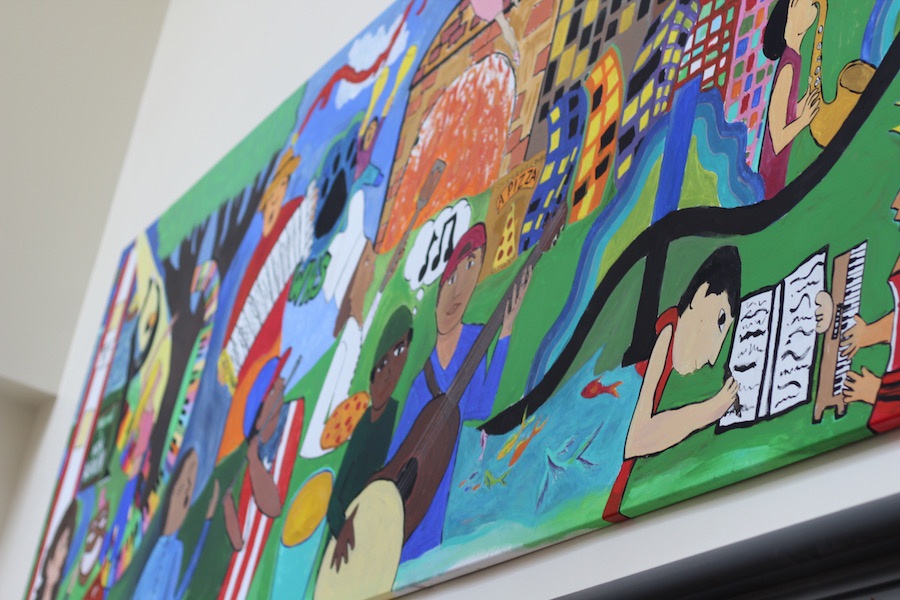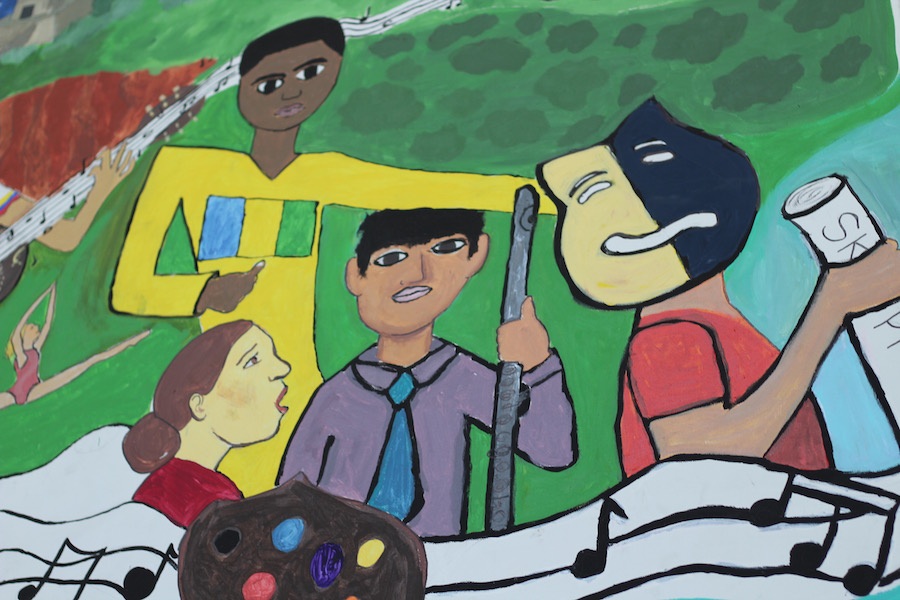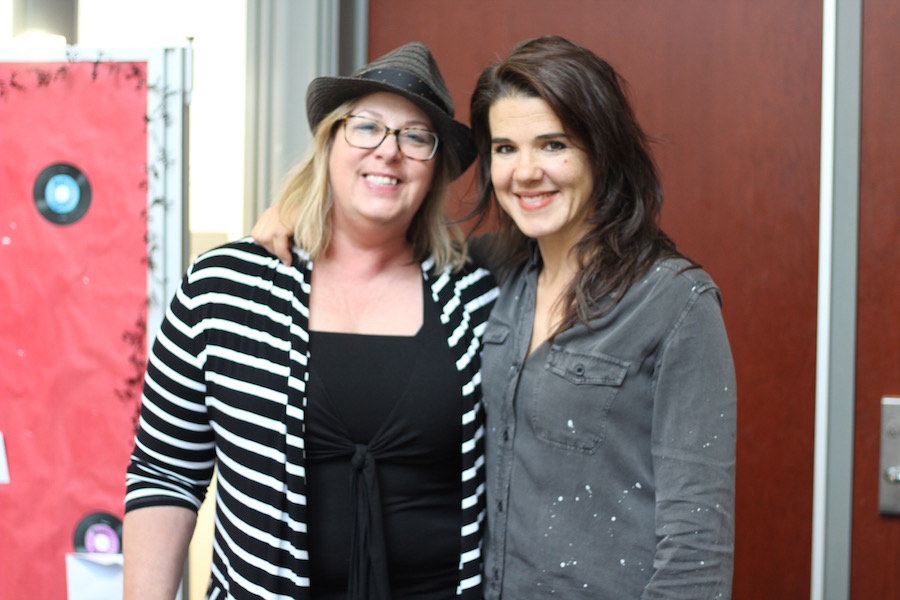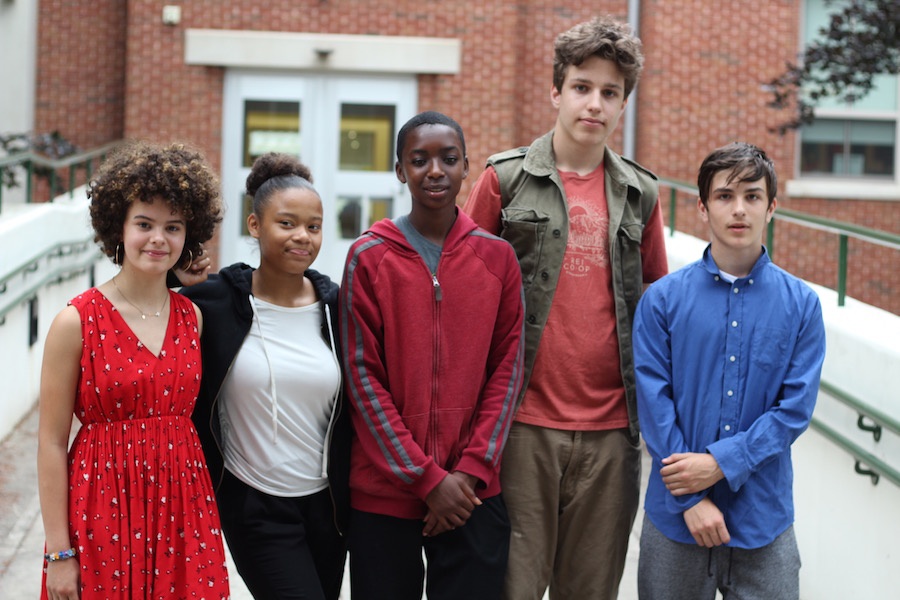
Maybe the first thing that catches you is the Soldiers and Sailors Monument, standing tall on East Rock in the light of a white crescent moon. Or the guitarist beneath its base, her brown hair cascading past her shoulders as she strums, and a flurry of notes fly from the instrument.
Maybe it’s the red-and-white lighthouse beaming out onto two dancers, or the flautist wearing the Puerto Rican flag, or the white-hatted chef at the center, a hot pizza in her hand.
They’re all meant to illustrate ”Neighborhoods of New Haven,” a new 22-foot mural by the departing eighth grade class at Worthington Hooker Middle School on Whitney Avenue. On Tuesday, all 38 graduating students gathered at the mural before heading into a National Honors’ Society ceremony in the school’s auditorium. The piece hangs outside its double doors like a huge, bright signpost.
The mural is a collaboration with the school’s art program and sculptor Susan Clinard, whose son Olivier is in the eighth grade at Hooker. Nine years ago when he was in kindergarten, Clinard began teaching students in his classes, introducing art projects to the curriculum four times a year. As Olivier got older, the projects got more complicated: clay, photography, mobile-making, and puppetry punctuating the students’ regular art classes.

But as Olivier approached eighth grade—and Clinard thought about a group of kids she’s worked with for almost a decade—she realized that she wanted to do something with a bigger creative footprint. Working closely with K-8 art instructor Judie Cavanaugh, Clinard helped all 38 students plan, design, sketch, paint and mount the mural, a process that took almost the entire academic year.
After looking at examples of muralismo from across the country, all 38 students agreed that they wanted to depict the “Neighborhoods of New Haven” from which they come, and with which they are familiar. Because of the mural’s size, they worked in batches, split into two art classes and then given shifts to work on the canvas itself.
It became a community project: while Clinard provided some of the supplies and volunteered her time, the Hooker Parent-Teacher Association (PTA) raised funds for the canvas. When they realized it would need a special frame, New Haven Awning Co. pitched in, offering to build a special frame and stretch the 22 x 6 foot canvas for a discounted rate. A small army of parents mobilized to mount the piece. And meanwhile, students took their design from sketchbook to draft to canvas, each contributing a figure, landmark, or New Haven symbol to the piece.

The dream team: K-8 art teacher Judie Cavanaugh and sculptor Susan Clinard.
“We just did it step-by-step,” Clinard recalled. “I really feel like I’ve been another art teacher since they were little ones, but I’ve never done anything like this.”
As it came together, Clinard said both she and Cavanaugh marveled at the diversity of figures on the canvas. Of the 42 nationalities at Worthington Hooker, many are represented, from a Venezuelan guitarist to lithe Rwandan dancer, body swaying over a cluster of music notes. As students worked, an image of a multicultural city materialized: ballerinas mid-split, accordion players and dramaturgs, roaring brick ovens, novelists lying belly-down in the grass. Behind a rendering of the Quinnipiac River Bridge, a series of buildings reach toward the sky, their windows blazing with light.
“For me, this project signified the eighth grade class coming together, and doing this amazing job on this legacy mural,” said Cavanaugh, a slight catch in her voice as she spoke. “This is truly a piece of them.”
Cavanaugh added that she’s known many of the students since they were in kindergarten, and has relished seeing them progress as artists in real time. She called the process and unveiling of the mural in late May “very emotional,” recalling how students gathered at a reception for the piece. She said that it’s bittersweet—she’ll be sad to see this crop of students graduate (she always is), but is glad that the mural will remain at the school long after their June 19 graduation has passed.

From left to right: Amélie Corazzini, Alyssa Eichler, Espoir Irumva, Cody Coon, and Olivier Clinard.
As she waited to head into the auditorium, student Kohatsu “Coco” Seto said that she’d been surprised by the mural’s profound effect on her as she prepared to head to Wilbur Cross and the Educational Center for the Arts (ECA) in the fall.
“Going on from now we’re going to go on to high school and part ways, so it was definitely really emotional, making every stroke on the canvas,” she said. “It was just like, our last time being together and making something.”
Her friend Amélie Corazzini gave her a sly little smile, then jumped in. On the righthand side of the mural, she has depicted herself in a flowery white blouse, playing the guitar. Black notes flow from between the strings.
“I think it was a nice way for all of us to be represented together,” she said. “Everyone contributed to this one mural, and it’s going to be really nice to come back one day years later and see it and remember our eighth grade year.”

Almost all of the students in Hooker's eighth grade class gather beneath the mural.
Others, like Espoir Irumva, said they used it as a chance to learn more about their classmates’ talents and interests. Headed to Platt Technical High School in the fall, Irumva first arrived in New Haven as a refugee from Rwanda. He has brought that background to the mural, his character dressed in a jersey with the Rwandan flag as he dances through the grass.
“It was one of the last biggest projects that I did with my classmates,” he said.
His friend Cody Coon jumped in.
“It’s who we are, and there’s a sentimentality because it’s the last thing we did together,” he said. “It’s a physical embodiment of what the eighth grade has brought together. It was just fun—less so of a monument, more so of coming together to work on it.”
“It’s not perfect,” he added. “It’s just us.”